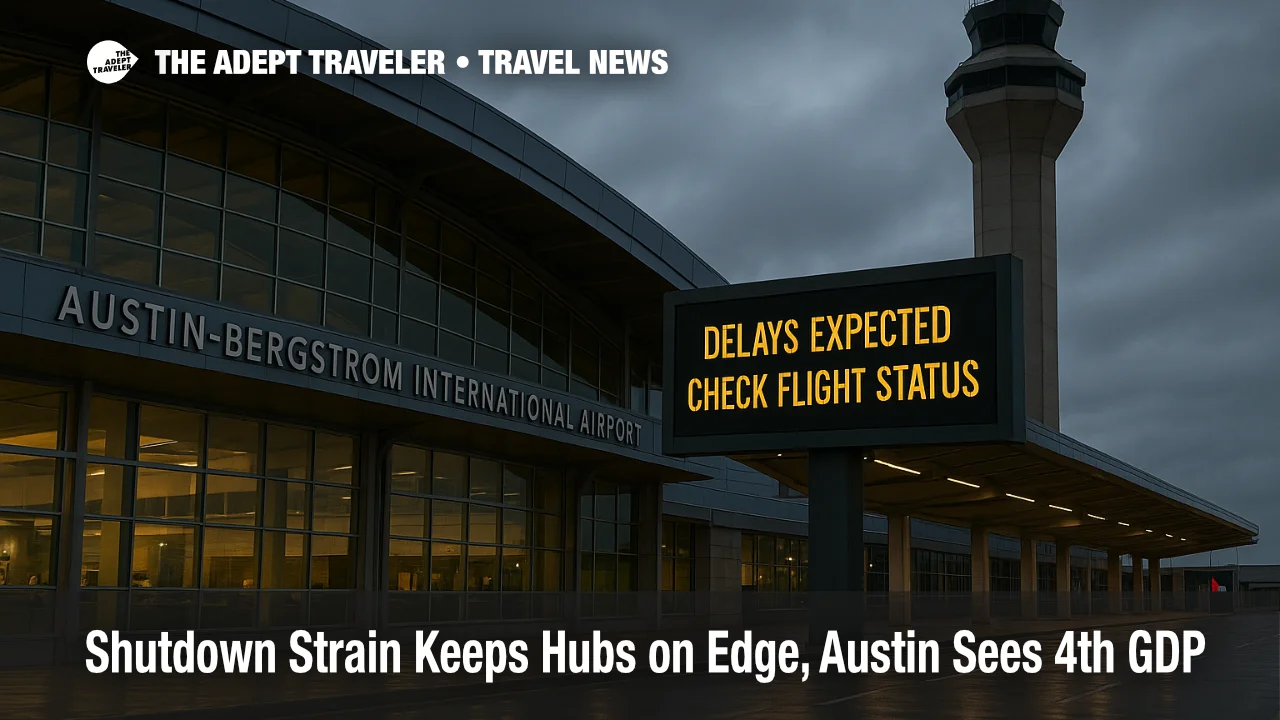Shutdown Strain Keeps Hubs on Edge, Austin Sees 4th GDP

Key points
- Austin-Bergstrom logged a fourth ground delay in a week on November 3
- FAA planning notes flag pop-up GDPs at multiple hubs during staffing shortages
- Most current airline waivers focus on weather and Melissa recovery rather than shutdown-specific relief
- Travelers should pad connections by one bank and monitor day-of FAA advisories
Impact
- Pad Connections By One Bank
- Build 60-90 minutes into transfers at staffing-thin towers and TRACONs
- Move To Earlier Flights
- Shift to early banks where schedules are less exposed to day-of GDPs
- Use Same-Day Change Tools
- Leverage airline apps to slide into unaffected departures when holds appear
- Verify Waiver Windows
- Most active waivers are weather- or Jamaica-recovery related, not shutdown-specific
- Watch FAA Advisories
- Check FAA NAS Status and Operations Plan for pop-up ground stops or GDPs
The shutdown's operational pressure continued to ripple through U.S. hub operations to start the week, with Austin-Bergstrom International Airport (AUS) logging its fourth FAA ground-delay program (GDP) in a week on Monday, November 3. Local reports placed the arrival delays between roughly 330 p.m. and just before 800 p.m. CT, with average inbound holds ranging from about 37 to 58 minutes and a brief ground stop lifted in the afternoon. Departures were less affected, but the sequence underscores ongoing risk as air traffic controllers (ATC) and Transportation Security Administration (TSA) officers work unpaid during the continuing shutdown.
What changed and who is affected
Austin has now seen repeat staffing-triggered GDPs since October 27, with the latest incident affecting nearly 100 flights by mid-afternoon Monday. The FAA's national planning advisories also pointed to possible day-of ground stops or GDPs at other pressure points, including Boston Logan, New York LaGuardia, Newark, and San Francisco, reflecting thinner staffing at key facilities. Travelers connecting across major hubs should expect intermittent rate reductions and pad itineraries accordingly.
Latest developments
FAA and industry sources describe a system operating safely but with reduced throughput when staffing dips, which produces pop-up traffic management initiatives. Recent national tallies show shutdown-era absences driving delays at multiple large airports, with Reuters estimating more than 3.2 million passengers have already been affected and planning notes calling out elevated risks around New York terminals on peak days.
Where delays are repeating
Beyond Austin, repeat staffing-linked constraints have hit New York's airports and select federal facilities in Texas and the Mid-Atlantic on recent days, with prior FAA notes citing GDPs at Chicago O'Hare, Washington Reagan National, and Newark during the last week of October. Monday's Texas coverage also highlighted Dallas-Fort Worth and Love Field delays, while Houston reported extended security waits. Expect this pattern to recur as facilities manage to the staffing they have.
How long to expect
For AUS on November 3, reported average inbound holds ranged from about 37 minutes (MySA) to roughly 58 minutes (Statesman), with maxima approaching two hours during the peak window before easing. FAA planning bulletins continue to warn of ground stops or GDPs "possible" or "probable" at specific hubs as the day evolves, so averages will vary city to city.
Airline waivers this week (Nov 4 window)
Major carriers' active public waivers remain concentrated on weather events and Hurricane Melissa recovery corridors rather than shutdown-specific relief. American, Delta, and United each show active or recent waivers tied to weather or Jamaica recovery; use them if your routing qualifies, but do not assume automatic fee-free changes unless the advisory lists your dates and airports.
Background
A GDP meters arrivals into an airport when capacity is constrained, issuing expected departure clearance times to upstream flights. During the shutdown, the FAA has leaned on these tools more often when facilities fall below staffing targets, which the agency and local reporting attribute to unpaid ATC and TSA staff and elevated fatigue. The U.S. Travel Association warned November holiday travel could be severely impacted if the shutdown persists.
Final thoughts
Shutdown-driven staffing strain is keeping hubs on edge, and Austin's fourth GDP in a week is a clear signal to build margin into your plans. Travelers should book earlier departures when possible, avoid tight domestic connections during afternoon banks, and check airline apps plus FAA advisories repeatedly on the day of travel.
Sources
- FAA Current Operations Plan Advisory
- FAA National Airspace System Status
- Austin: Nearly 100 Flights Impacted, 4th Ground Delay
- Austin: Ground Delay Details and Averages
- Austin: Ground Stop/Delay Timeline
- Reuters: 3.2 Million Passengers Impacted by Shutdown
- American Airlines Travel Alerts
- Delta Exception Policy Archive
- United Travel Alerts
- United Jetstream, Multiple Active Waivers
- U.S. Travel Association Letter on Shutdown
